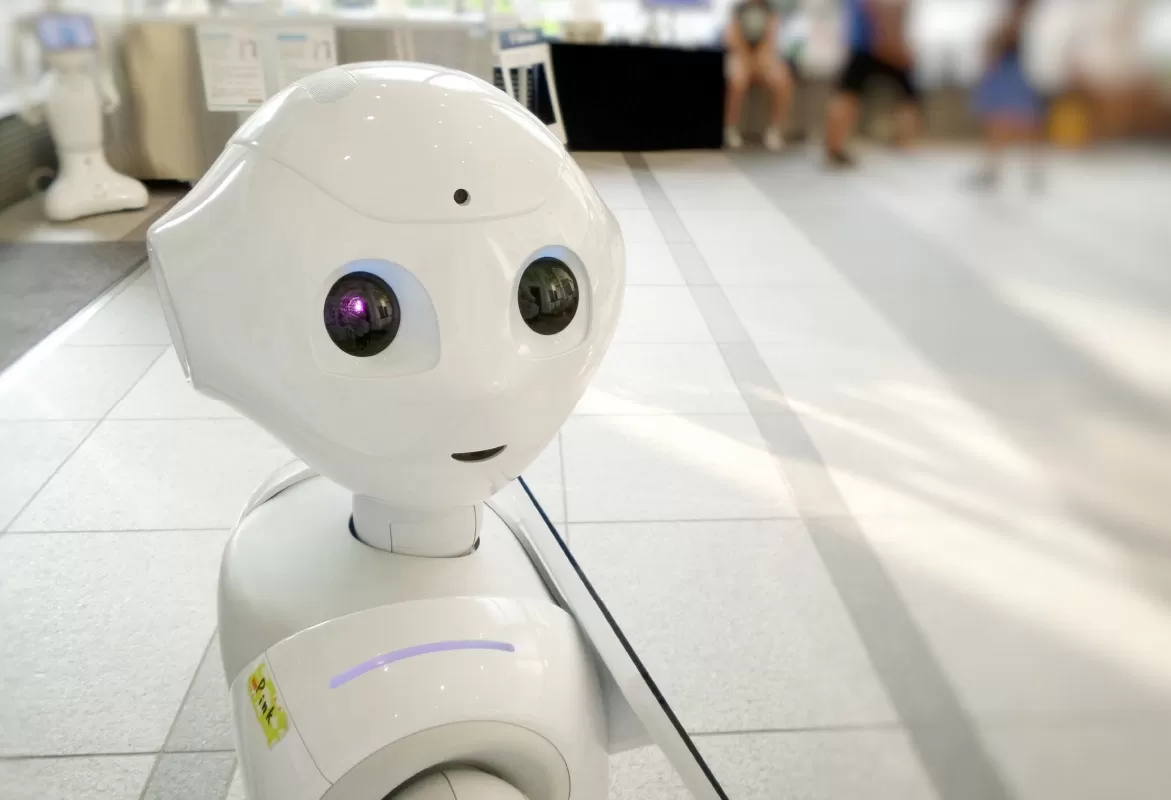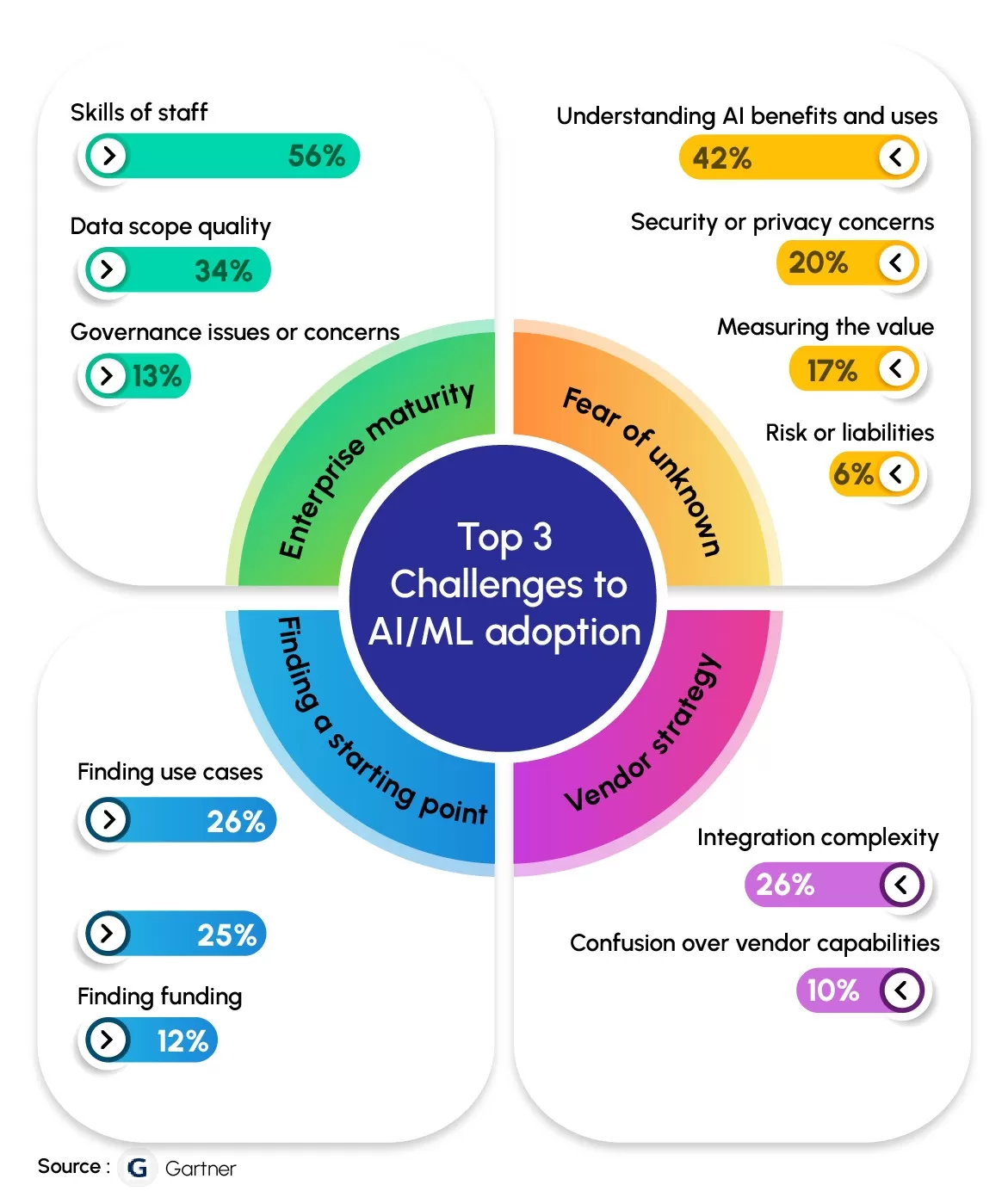
In today’s fast-paced business landscape, harnessing the power of Artificial Intelligence (AI) and Machine Learning (ML) is crucial for staying competitive. However, setting up an AI/ML platform in your organization is not a one-size-fits-all endeavor. It requires careful planning and the right technology and architecture choices. In this comprehensive guide, we’ll walk you through the process of setting up an AI/ML platform and explore the nuances of both technologies.
What is the difference between AI vs. ML
We have often used these terms interchangeably. Similarly, I suppose as we use the terms ‘sweets’ and ‘chocolates’, though chocolate is a sweet not all sweets are chocolates. So, what exactly is the difference between AI and Ml technology and how is the difference important in practice for organizations?
Artificial Intelligence (AI) refers to the broader concept of creating machines or systems that can perform tasks that typically require human intelligence. These tasks include reasoning, problem-solving, natural language understanding, and perception. AI in business applications encompasses various techniques, including ML.
AI can incorporate a wide range of techniques beyond ML, including rule-based systems, expert systems, natural language processing, and more. In contrast, ML is primarily concerned with data-driven learning and pattern recognition.
Machine Learning (ML) is a subset of AI that focuses on the development of algorithms and models that allow computers to learn from data and make predictions or decisions without explicit programming. ML algorithms use statistical techniques to improve their performance over time.
They excel at pattern recognition, classification, regression, and clustering but lack the broader reasoning and understanding capabilities of AI.
Examples of Machine Learning Applications: ML is widely used in applications like recommendation systems (e.g., Netflix recommendations), image and speech recognition, fraud detection, and autonomous control systems (e.g., self-driving cars).
ML is concerned with achieving high task performance in specific domains rather than replicating human-like intelligence across various tasks.
Also Read: Generative AI Will Redefine Business Operations – Generative AI Use Cases
What Organizations Must do to Set Up an AI/ML Platform
Setting up an AI/ML platform in your organization is a multifaceted endeavor. By carefully planning and executing these steps, you can unlock the transformative power of AI and ML.
1. Define Your Goals and Use Cases: Companies using AI start with defining their organization’s specific goals for AI/ML. Define clear use cases to guide your platform setup.
Think about leveraging AI in business processes to automate tasks that are repetitive or time-intensive, elevate decision-making processes, enhance precision, or enrich the overall customer experience. Once you’ve defined your business objectives, align them with the potential advantages of AI to ensure a successful integration.
2. Data Collection and Preparation: High-quality data is the foundation of any successful AI/ML initiative. Gather, clean, and preprocess your data to ensure it’s accurate, relevant, and representative of your problem domain.
3. Choose Your Technology Stack
Once again your AI implementation proces will depend upon your application – will it be domain specific (ML) or more encompassing (AI)
(AI Platform Components)
- Natural Language Processing (NLP): If your AI in business use cases involve text data, consider NLP libraries like NLTK, SpaCy, or the Hugging Face Transformers library.
- Computer Vision: For image and video processing tasks, frameworks like OpenCV and deep learning libraries such as TensorFlow and PyTorch are valuable.
- Speech Recognition: Utilize libraries like CMU Sphinx or cloud-based solutions like Google Cloud Speech-to-Text for audio-related tasks.
- Reinforcement Learning: If your applications require decision-making, explore reinforcement learning libraries like OpenAI Gym or RLlib.
ML Platform Components:
The choice of ML framework depends on your specific use case and requirements:
- TensorFlow is versatile and suitable for a wide range of applications, including deep learning and deployment.
- PyTorch is favored for research and dynamic computation, especially in the deep learning field.
- scikit-learn is ideal for traditional machine learning tasks and prototyping.
- Keras is excellent for building neural networks and deep learning models, often used with TensorFlow as a backend.
Other considerations for AI implementation are:
- Leverage tools like Apache Spark or Dask for large-scale data processing and feature engineering.
- Platforms like Kubernetes, Docker, and cloud services such as AWS SageMaker or Google AI Platform simplify model deployment.
- Design an architecture that can scale horizontally to accommodate increased workloads.
- Implement resource management strategies like containerization and orchestration to efficiently utilize computing resources.
- Companies using AI will need to develop streamlined pipelines for model training, validation, and deployment.
- Implement robust security measures to protect sensitive data and models.
- Ensure compliance with relevant data protection regulations (e.g., GDPR, HIPAA).
Maintain comprehensive documentation to facilitate knowledge sharing and troubleshooting.

The Importance of Working with a Proven AI Development Partner
Setting up an AI/ML platform is a complex and resource-intensive process. If your in-house development team has not worked on AI technology, there is always the first time to start. However, most organizations are reluctant to hire and maintain a skilled AI team to navigate the intricacies successfully. This is often the deciding reason why most companies reach out to AI companies like iTech since they know it’s crucial to collaborate with a proven AI development partner.
Here are the top most reasons for working with an AI Partner:
- Access to Specialized Skills: AI development requires expertise in machine learning algorithms, data engineering, and cloud computing. An experienced partner brings these skills to the table.
- Real-World Experience: Proven partners have a track record of implementing AI solutions across various industries, providing valuable insights into what works and what doesn’t.
- Accelerated Development: Collaborating with an established AI development partner can expedite the setup of your AI/ML platform, helping you bring AI-powered solutions to market more quickly.
- Mitigating Technical Risks: AI projects can be prone to technical challenges. A seasoned partner can anticipate and address issues, reducing the risk of costly setbacks.
- Compliance and Security: Handling sensitive data and ensuring regulatory compliance is critical. The best AI companies understands the intricacies of data security and compliance, reducing legal and reputational risks. iTech is both HIPAA and GDPR compliant. We are also ISO27001, ISO27701, and SOC2 certified!
- Efficient Resource Utilization: Experienced partners can help optimize resource usage, minimizing unnecessary expenses.
- Scalability: A partner can design scalable architectures that allow you to grow your AI capabilities without incurring significant overhead.
The Scope of Responsibility
For a successful partnership, it’s essential to define the responsibilities of both your organization and your AI development partner clearly:
Organization’s Responsibilities for AI Implementation
1. Clear Business Objectives are important at the outset. Define your AI/ML goals and use cases, ensuring they align with your overall business strategy.
2. Provide access to relevant and high-quality data, maintaining data privacy and security.
3. Share industry-specific knowledge and insights that can help refine AI solutions.
4. Actively engage in the development process, offering feedback and collaborating closely with the partner’s team.
5. Allocate the necessary budget and resources for the AI project, including infrastructure and personnel.
6. Compliance and Legal Oversight – Ensure compliance with data protection and industry-specific regulations, with legal oversight when necessary.
AI Development Partner’s Responsibilities
1. They will leverage their AI and ML technical expertise to design, develop, and deploy AI solutions that meet your objectives.
2. Your AI partner is responsible for Data Engineering. This includes data preprocessing, feature engineering, and data pipeline development.
3. They will develop machine learning models tailored to your use cases, optimizing for accuracy and efficiency.
4. They will also be responsible for designing scalable architectures and manage the deployment of AI models, whether in the cloud or on-premises.
5. They must iImplement robust security measures and ensure compliance with data protection regulations.
6. Set up monitoring systems to track model performance and provide ongoing maintenance and support.
7. Maintain open and transparent communication with your organization, keeping you informed about project progress and addressing concerns promptly. This is not an after thought, it starts from day one.
Conclusion
Collaborating with a proven AI development partner can significantly enhance the success of your AI/ML initiatives. The best AI companies have the expertise, experience, and resources that can help you navigate the complexities of AI development, reduce risks, and accelerate time-to-market. Together, you can harness the full potential of AI and drive innovation in your industry. If all this seems most confusing, talk to our AI team experts to get more clarity for your AI applications.

Biju Narayanan
Biju is an emphatic people management leader and works by the vision that change is the door to new opportunities and innovation. As Director, he has been guiding iTech on a path of innovation for over 19 years. iTech is a full-service custom software company with a large portfolio of successful domestic and international projects including Fortune 500 organizations. Biju specializes in the healthcare, sports and logistics industries with particular focus on AI and ML. Outside of work, you may find him hitting a lethal jump smash on the badminton court and he is also a creative artist.


